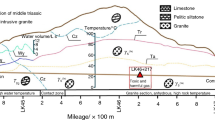Conclusions
-
1.
Tunnels with a cross section of 6–10 m2 can be ventilated successfully over a length of 4–4.5 km by 600 mm diam metal air ducts if the pipes are air tight and rubber gaskets are used at the joints.
-
2.
With the combined method of ventilation there is a reliable and rapid ventilation of the face, the spread of contaminated air over the tunnel is eliminated, and the delivery of fresh air along the entire working face in the tunnel is provided.
-
3.
The quantity of air needed for ventilating small-section tunnels driven in strong rock is determined primarily by the explosive charge and the adopted ventilation time of the face after the explosion.
-
4.
The placement of auxiliary axial fans on the main air duct overcomes resistance in the line, which in turn leads to a decrease of ventilation time of the face.
Similar content being viewed by others
Additional information
Translated from Gidrotekhnicheskoe Stroitel'stvo, No. 5, pp. 53–54, May, 1967.
Rights and permissions
About this article
Cite this article
Aliferov, A.N. Ventilation of the Yalta hydraulic tunnel during construction. Hydrotechnical Construction 1, 482–483 (1967). https://doi.org/10.1007/BF02382703
Issue Date:
DOI: https://doi.org/10.1007/BF02382703




